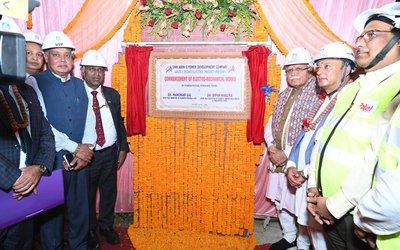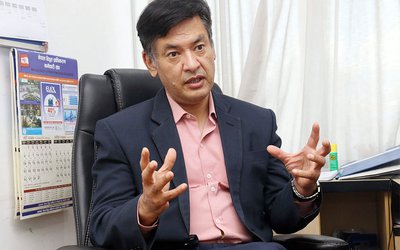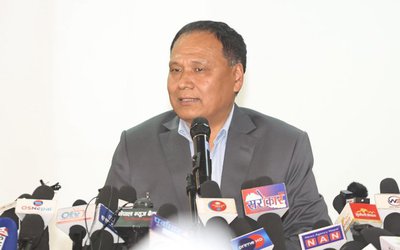Uncertain about what to do back home, Ram Krishna Yadav, 26, of Dhalkebahar Village Development Committee of Dhanusha District, is returning home after his employer, a Saudi Arabian Construction Company, announced a reduction in the number of its workers. Along with Yadav, 15 other Nepali workers were part of the layoff package.
Although Yadav and his Nepali colleagues were recruited for three years on a contract two years ago, the company announced the layoff plan following the postponement of some of its new projects.
“We have told that the government has decided to defer some of the infrastructure projects due to the lack of enough revenue to back them. Many other companies are also making similar announcements. Many other Nepali people working in Saudi Arabia will return within a year,” said Yadav, who is very worried about the situation back home with no employment opportunity.
“I don’t know what I will do. I will come back to Kathmandu or do some local business,” said Yadav. “I am lucky to have a good company which provided us three months' advance payment. There are many others who have not paid money for even six months.”
At a time when the international labor market is heading towards a new crisis and tens of thousands of Nepali people are likely to return home, Nepal’s political leaders are busy in power sharing with no plan for the migrant returnees.
Ministry of Labor and Employment, which is responsible to develop the plan, is yet to announce any contingency package for those returning home. As the country is heading towards a political chaos, a large number of returning foreign workers will be likely to create a social unrest.
“The ministry is working on this direction. Although the number of Nepalese leaving for foreign employment has reduced in the last few months, the trend of returnees is not alarming,” said the spokesperson of Ministry of Labor and Employment.
Recently released economic updates of Asian Development Bank have predicted a bleak scenario.“Consistent with the slowdown in the number of overseas migrant workers, official remittance inflows decelerated to 0.8% in US dollar terms in FY2016 from 12.2% in FY2015 and 11.9% in FY2014. However, the still higher growth rate of remittances compared to GDP growth resulted in its share of GDP to increase to a record 29.6% in FY2016 (equivalent to $6.3 billion), up from 29.1% of GDP in FY2015 and 27.7% of GDP in FY2014.22 Remittance is an important contributor to reducing absolute poverty and over 56% of households receive remittances in Nepal. About 80% of household remittance income is spent on daily consumption goods and about 2.4% in capital formation. Remittances income has been the prime factor supporting steady services sector growth and for financing imports. The recent decline in the number of overseas migrant workers and the subsequent deceleration of remittance inflows poses a downside risk to reducing poverty, supporting economic growth and to maintaining external sector stability,” said Asian Development Bank’s Economic Update.
The report of Department Foreign Employment showed that the growth of migrant workers further decreased by 18.4% following a decrease by 2.8% in FY2015. In FY2014, it had increased by 16.4%. The recent slowdown in the number of overseas migrant workers is triggered by the investment slowdown in the Gulf countries following low oil prices, the decision of Malaysian government to halt fresh recruitment, and the availability of jobs related to post-earthquake reconstruction.
According to the report, a total of 418,713 migrants legally left to work overseas in FY2016 (daily average of 1,147), down from 512,887 in FY2015 and 527,814 in FY2014 (daily average of 1,466). The number of migrant workers to Malaysia drastically decreased to 60,979 from 202,828 in FY2015 and 214,149 in FY2014. Qatar, Saudi Arabia and Malaysia were the top employment destinations for low and semi-skilled Nepali migrant workers. They together accounted for about 78% of total migrant workers in FY2016, down from 83% in the previous year. Japan and South Korea absorbed 3,844 and 7,432 migrant workers, respectively.
Balance of Payments
As the flow of remittance declines, it will affect the balance of payments. For the past one decade, remittances have greatly contributed to make the balance of payment in Nepal’s favor. As Nepal’s export continues to decline with a huge trade deficit, remittances have helped to maintain the balance. Despite the deceleration of remittance inflows, the lower external trade deficit resulted in further strengthening of the external situation in FY2016.
“The balance of payments surplus reached $1.8 billion (8.5% of GDP) in FY2016, up from $1.5 billion in the previous year. The large merchandise trade deficit, which declined to 30.3% of GDP from 31.3% of GDP in FY2015, was partially25 offset by workers’ remittances, which hit a record 29.6% of GDP, and export (3.3% of GDP), resulting in a current account surplus of $1.3 billion (6.2% of GDP), up from 5.1% of GDP in FY2015. Meanwhile, FDI inflows increased to $55.8 million from $44.2 million in FY2015. Gross foreign exchange reserves increased from $8.1 billion in FY2015 to $9.7 billion in FY2016, sufficient to cover 14.1 months of import of goods and non-factor services,” says ADB’s Economic Update.
Migration for foreign employment has become a major source of income for many Nepali households. Labour Migration for Employment: A Status Report for Nepal 2013/14 shows that the number of migrants leaving Nepal for work is increasing every year.
During the last fiscal year, that is, 2015, more than 520,000 labor permits were issued to Nepalis planning to work abroad. Malaysia was then the number one destination country for Nepali migrants, closely followed by Qatar, Saudi Arabia, UAE and Kuwait.
Along with supporting BOP, remittances have become a major contributing factor to increasing household income as well as to the national GDP. In 2013, remittance inflows topped US$5 billion, or 25 per cent of the national GDP. This placed Nepal third among the countries receiving the highest proportion of remittances in terms of GDP.
Nepali migrant workers make an enormous development contribution to their home country but also to the destination countries where they fill labour market niches by doing jobs that nationals are unable or unwilling to fill.
For Nepal, migration is not a new phenomenon as it is a centuries old practice in Nepal to go to India or abroad for jobs. People have always migrated in search of better opportunities. Migration to India for work has a long history in Nepal, while labor migration to other countries began in the 1990s with the adoption of liberal economic policies.
As Nepal and India share an open border and requiring no permission to work, it is difficult to put an exact figure on the number of Nepali migrants travelling to India for work. The World Bank estimates that 867,000 Nepalis are working in India.
With the decade long insurgence and then the prolonged political instability with nine governments in ten years, Nepal’s ability to generate employment has declined. Power crisis, frequent strikes and unstable government badly impacted the industrialization process. The labor unrest and deteriorating law and order too has pushed investors out of the country.
An estimated 400,000 young people enter the labor market each year and, in the absence of decent employment opportunities in Nepal in rural areas, migration to India and overseas for employment is an attractive option for many youth.
According to a study, remittances constitute nearly 23% of GDP. However, most remittances are used by households to cover consumption needs and repayment of debts rather than for investment in productive sectors that can create avenues for breaking the migration cycle and have an impact on the development of Nepal’s economy.
Although the country’s political leaders have been harping on the idea to increase the number of employment in home, foreign employment has become a viable livelihood option for millions who are unable to find work within the country.
Qatar, Malaysia, Saudi Arabia, the UAE, and Kuwait are the top five labor destination countries with the highest number of Nepali migrant workers.
According to the Department of Foreign Employment, from January to October 2016, about 300,000 Nepali citizens (women and men) migrated abroad for work.
As most male Nepali migrant workers are employed in low-skilled sectors, such as construction and manufacturing, whereas the majority of female migrants work in the informal sector, either as caregivers or housemaids, they are paid low. Had they been given proper training with new skills, Nepal would have benefited much more.
Although Nepal government is attaching many strings now for foreign employment, the external environment is likely to be less favorable as well. “The Nepali economy is extremely dependent on remittances, which comprise around 30 percent of GDP. The oil-exporting Gulf Co-operation Countries and Malaysia are the destinations of almost 97 percent of Nepali migrants (excluding those going to India) and a key source of remittances. As oil prices in particular, and commodity prices in general, are expected to remain at their current levels during the forecast period, the possibility of a slowdown in remittances remains,” noted the the World Bank Economic Update.
“Given that remittances enable the consumption- centric structure of the Nepalese economy and that the government relies on taxation of imports as a major source of revenue, even a modest contraction in remittances would have an adverse effect on growth and fiscal and external accounts, in addition to curtailing economic opportunities for Nepalese abroad."
There are several near and medium-term challenges ahead for Nepal. Effective mobilization of post-earthquake reconstruction, full recovery of exports, and the successful holding of various upcoming elections are key near-term challenges. Additionally, the trade disruptions have highlighted the urgent need to diversify the Nepali economy, particularly in terms of fuel trade and transport options.
According to the World Bank, Nepal faces several simultaneous and daunting challenges in medium terms. These include the challenges of completing the political transition and setting up a new federal structure while attempting to leverage its endowments (such as hydropower potential and human capital) to achieve faster growth, reduce poverty, and create economic opportunities for its citizens at home.
With many returnees like Yadav in uncertainty about what to do, Nepal’s social and economic prospects will be uncertain as well. As the political process continues to head towards a chaotic course, economic and social crises may push Nepal into greater troubles.
Nepal top remittance recipient economy
As a proportion of the gross domestic product (GDP), Nepal topped the chart among top 10 inward remittance economies in Asia and the Pacific in 2015 due to recession in the Russian Federation and a spike in inflow to the country following the devastating earthquake. The country, however, stood second last in nominal terms and last in terms of per capita in the ranking last year.
According to the ‘Asian Economic Integration Report 2016’, released today by Asian Development Bank, remittances and tourism receipts are an increasingly important and stable source of external financing for many developing Asian economies. On average, remittances in 2015 accounted for one per cent of GDP ($271.1 billion) in Asia and the Pacific including the region’s more advanced economies.
The report has revealed that South Asia and Central Asia are most dependent on remittances. For example, remittance receipts in Nepal and Tajikistan reached 31.5 per cent and 28.9 per cent of their respective GDP in 2015. “A slowdown in remittances from the Middle East and the Russian Federation due to the oil price plunge and the economic slump underscores the growing challenges of economic diversification and strengthening competitiveness in these sub-regions,” the report says.
The report looked into the top 10 remittance recipient economies in Asia and the Pacific in 2005, 2010, and 2015. In nominal terms, India was highest in all three years. The Philippines ranked second in 2005 and 2010, but fell behind China in 2015 amid low oil prices, which also affected the earnings of Filipino migrants from major oil-exporting economies in the Middle East.
As a proportion of GDP, Tajikistan and the Kyrgyz Republic were highest in 2010, but they were overtaken by Nepal in 2015. In per capita terms, the rankings were dominated by the smaller economies in Central Asia and the Pacific in 2015, with Tonga, Samoa and Armenia topping the list.
According to the World Bank, global remittances dropped 2.7 per cent in 2015 from 2014 and are expected to pick up at a weak pace of 0.8 per cent in 2016 against the continued backdrop of weak economic growth in source economies and low oil prices.
“In addition, structural factors such as tighter bank controls to curb money laundering could make flows through informal remittance channels more attractive,” the ADB report says. “Tighter immigration and work visa policies also pose risks to remittance growth.”
Remittances have a huge impact in the countries that receive them. World Bank figures show that in 2015, remittances to Nepal they make up nearly one-third of total GDP.
Much of the money migrants send home is spent on food and immediate household needs. But there is evidence to show that many recipients are using the money to ensure a more secure and healthier future for their families.
With the job abroad shrinking and number of Nepali people leaving the country declining, it is likely to have a drastic impact on the flow of remittances. Given the bleak scenario, many implications are likely for Nepali economy as banks have already indicated where Nepali economy is heading with the increase in their interest rate.

Keshab Poudel
Poudel is the editor of New Spotlight Magazine.
- KUL MAN GHISING: Bowing Down To The People
- Apr 13, 2025
- POLITICAL VIOLENCE: Culture of Impunity
- Apr 11, 2025
- PM OLI MEETS PM MODI: No Progress
- Apr 09, 2025
- PM OLI’S THAILAND VISIT: Flip Flop
- Apr 08, 2025
- FM Dr. Deuba’s India Visit: Mission Aborted
- Mar 26, 2025















